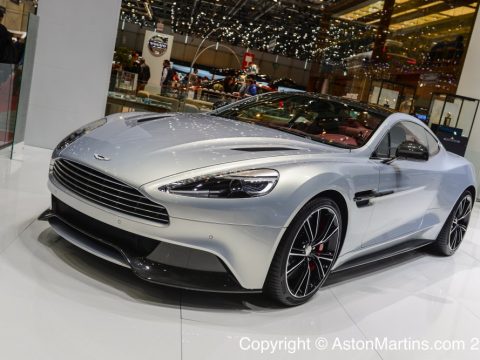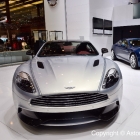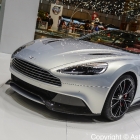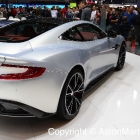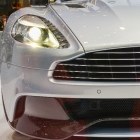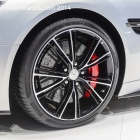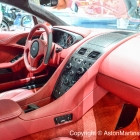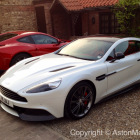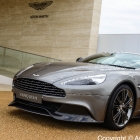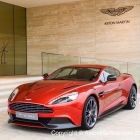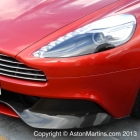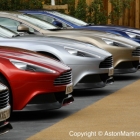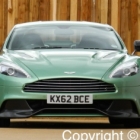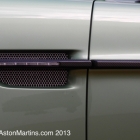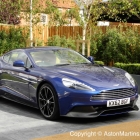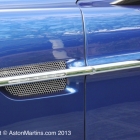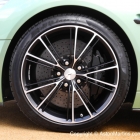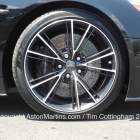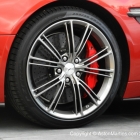The body is a significant and deeply sculpted evolution of the DB9/DBS/Virage line with many design queues from the One-77. It sits on a skirt of exposed carbonfibre which is also a nod to it being the first series production Aston with all the outer body panels formed of carbonfibre. Of special note is the rear wing or ‘Aero Duct’ as AML call it on the rear boot lid, plus the elongated side strakes and LED rear light blades both influenced by the One-77.
The V12 engine, with the codename AM11, still displaces 5935 cc but has been totally re-engineered with double variable valve timing, new heads, fully machined combustion chamber, bigger inlet valves and throttle bodies, and new ‘big wing’ manifolds. This has launched the power output from 510 bhp, (DBS and V12 Vantage) to 565 bhp and torque up by an additional 30lb ft across the rev range. The engine is mounted 19 mm lower in the chassis, principally to provide greater bonnet clearance in impacts with pedestrians, but usefully drops the centre of gravity of the car by 10mm. Power is transmitted to the rear wheels by an aluminium torque tube and carbon fibre prop shaft transferring power to the latest version of the ZF six speed Touchtronic 2 automatic gearbox. This was chosen above a traditional manual or automated manual as the Vanquish is principally a GT car rather than out-and-out sportscar. The early cars had a top speed is 183 mph with brisk acceleration to 62mph in only 4.1 seconds. The new AM11 engine also featured lower CO2 emissions and improved fuel economy.
The Vanquish is based on a revised and stiffer 4th generation (Gen4) VH architecture, the tub has evolved to be a carbon and bonded aluminium hybrid along with a new design of engine brace, improved anodising and bonding which has increased structural stiffness by 30%. Indeed, the evolution of the VH architecture is 75% brand new. Despite being a shade longer, wider and taller than the outgoing DBS, the Vanquish is, at 1739 kg, 56 kg lighter than the car it repalced.
The interior has received the total redesign, not dissimilar to the One-77, in an effort to bring it right upto date but also to physically increase space for passengers. The prominent centre stack is beautifully formed with brand new B&O audio, navigation, telephone and ventilation controls. The Vanquish has been made more spacious, principally by moving the facia 20mm away from the occupants and reducing it’s volume. This has liberated more legroom and knee room and by mounting the doors higher, has made more elbow and shoulder room too. Just like the original V12 Vanquish, the new version is available as a 2+0 or optional 2+2 seating. In addition, the boot has been made significantly larger too, a massive 60% larger than the outgoing DBS.
Deliveries began for UK and continental European customers towards the end of 2012, with a UK listed price from £189,995. From 2013, the Vanquish was also available with bespoke enhancements from ‘Q by Aston Martin’.
Announced in August 2014, the 2015MY Vanquish may look virtually the same as the previous model year but under the carbon coachwork the changes are most significant. The most significant update has been the adoption of a new 8 speed gearbox by ZF, the Touchtronic III which allows for gearchanges in as little as 130 m/s. Also the engine, now to AM29 spec has been revised with a little more power and torque but incredibly less emissions and better fuel economy due to the new Bosch engine management system. Quoted top speed rose to 201 mph and the 0 to 60 acceleration times dropped to just 3.6 seconds mostly due to a final drive ratio of 2.73:1. Aston Martin engineers also worked to produce an all-new torque tube to transfer power from the AM29 engine to the Touchtronic III gearbox. It’s unique new outer case design produced a 2kg weight saving whilst reducing driveline noise and vibration felt by passengers.



